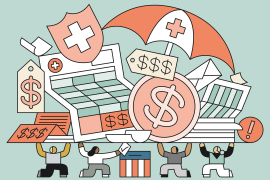The Biden administration’s $1.9 trillion American Rescue Plan is a massive public health and economic blueprint. But even as it makes much-needed improvements in access to affordable marketplace coverage, the proposal fails to address a striking health inequity: the lack of a pathway to affordable health insurance for the poorest Americans living in states that refuse to expand Medicaid. It is unclear when policymakers will return to this problem; the president’s plan does not include even a temporary patch.
The plan does appropriately and permanently address urgently needed affordability corrections to the Affordable Care Act’s (ACA) health insurance marketplace. Affordability always has been the marketplace’s most serious shortcoming; a 2018 Commonwealth Fund survey showed that more than two of five marketplace shoppers reported serious problems securing reasonably priced coverage. Under the plan, no family would pay more than 8.5 percent of household income for insurance, a dramatic improvement for families with incomes that exceed the subsidy cutoff of 400 percent of poverty (i.e., annual income of $51,040 for an individual and $104,800 for a family of four). The plan also would increase the subsidies available to families at the lower end of the income scale. These corrections are long overdue.
But what the Biden plan does not address is the plight of residents in the dozen states that have not adopted the ACA’s Medicaid expansion. Another two states – Missouri and Oklahoma – have adopted expansion but have not yet implemented it. In these 14 states, millions of the nation’s poorest adults are facing a pandemic without health insurance because their state has yet to take the step of extending medical assistance to all working-age adults with incomes up to 138 percent of poverty (i.e., annual income of $17,609 for an individual and $36,156 for a family of four). The president’s proposed marketplace corrections will not help them. Their incomes are below the eligibility threshold for marketplace assistance, which does not start until household income reaches 100 percent of poverty (i.e., annual income of $12,760 for an individual and $26,200 for a family of four), which is more than full-time work at the minimum wage. Disproportionately Black and from the Southern states, they are uninsured because they are too poor.
The problem dates back to the U.S. Supreme Court’s landmark 2012 decision that upheld the constitutionality of much of the ACA but declared the Medicaid expansion unconstitutional. The Court partially remedied the crisis it created by making expansion optional for the states. States could still move forward, if they wished, and have their expansion funded by the federal government.
But 12 states have not expanded Medicaid, and to date, arguments about the long-term cost effectiveness of expansion and the opportunity to improve health care access for the poor have not moved them. Furthermore, because the Medicaid expansion is optional, the 38 states and D.C. that have adopted the expansion could at any time reverse course and scale back coverage, meaning that any solution to a state’s nonexpansion decision should ideally take steps to reduce the likelihood that expansion states will decide in the future to opt out.
In one sense, the repair is obvious: a federal fallback system of subsidized marketplace coverage for residents living in nonexpansion states. While marketplace coverage is not as generous as Medicaid in terms of benefits or cost-sharing protections, a fallback would provide dramatic, immediate relief to the uninsured poor. But because the ACA Medicaid expansion is optional, any state would have the legal right to drop expansion, and the fallback would also serve as a backup if states that have expanded decide to drop out.
A fallback option would provide useful coverage, but it would be far better to encourage the remaining states to expand Medicaid while encouraging those that have done so to maintain expansion. As Gail Wilensky and I have written elsewhere, there are numerous strategies for encouraging states to maintain expansion. Congress could offer expansion states additional funding enhancements or allow them to lower the current upper income eligibility for marketplace coverage from 138 percent of poverty to 100 percent of poverty.
These proposed solutions are admittedly complex. That shouldn’t prevent us from helping millions of Americans gain needed coverage in the midst of an economic and public health crisis. A short-term answer is to provide impoverished residents in nonexpansion states with access to no-cost premium coverage through a special enrollment period in the marketplace. This special coverage could last for the duration of the public health emergency and for a time afterward, given the significant number of people experiencing long-term consequences of COVID.
This type of short-term patch does not solve the bigger problem facing residents in nonexpansion states after the pandemic ends. But by giving nonexpansion state residents access to emergency-related coverage through the marketplace, policymakers at least will provide a desperately needed remedy for people who, through no fault of their own, are enduring a pandemic without affordable insurance.




